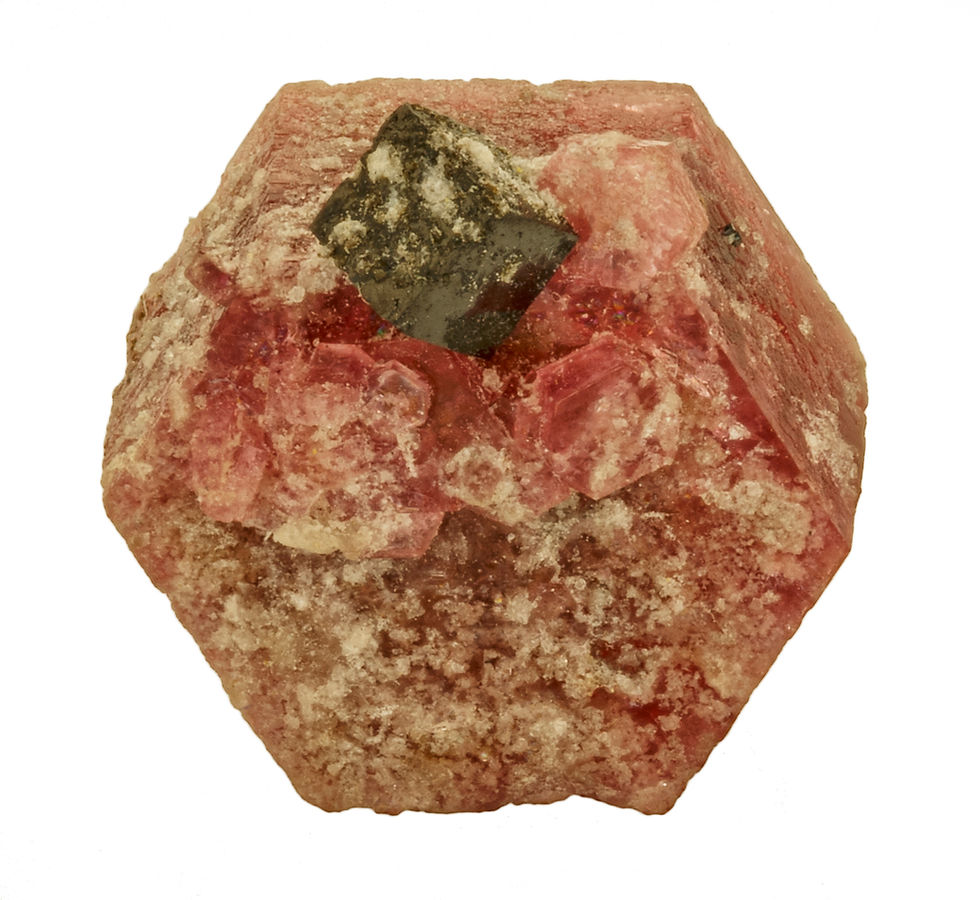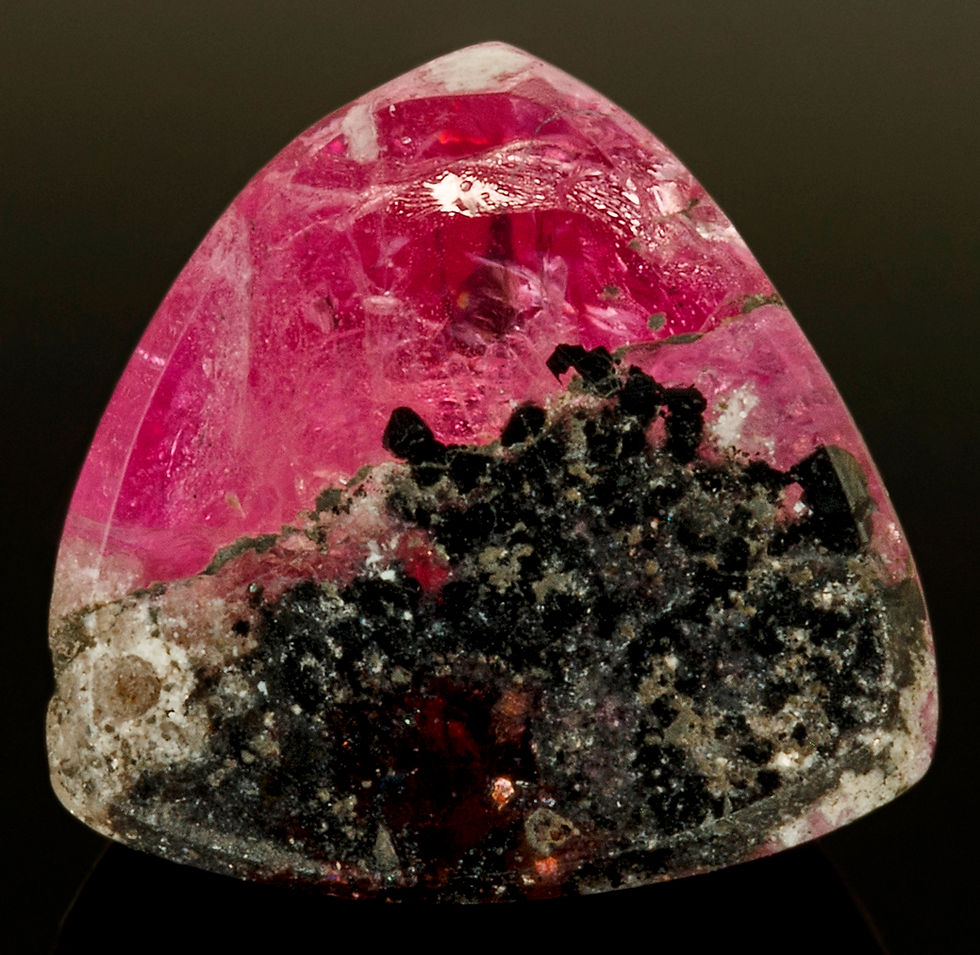Red Emerald Inclusions: Bixbyite
- Seth William Rozendaal
- Aug 23, 2017
- 7 min read
In their book series Photoatlas of Inclusions in Gemstones, Dr. Edward Güeblin and John Koivula highlighted the importance of inclusions to the field of gemology. Conclusively classifying one small crystal inside another can positively identify the origin of a mineral, narrowing a broad or undefined area down to an exact mine or locality. Furthermore, specific types of inclusions can have a phenomenal impact on a gemstone's appearance and nature.
The topic of today's article is a mineral frequently-observed in and fundamentally important to the Red Emerald -- Bixbyite.

Modified Bixbyite crystal included in the pavilion
of a Red Emerald round brilliant.
Before Red Emeralds of gem quality were ever found, famed rockhound and mineralogist Maynard Bixby discovered highly-included red beryl wafers in the Thomas Range during his exploration of Utah mineral localities in the 1890s. By 1912, Dr. Alfred Eppler suggested naming the new beryl Bixbite to honor its discoverer.
Maynard also discovered a black mineral similar to Pyrite in the same location. These dark metallic cubes were named after him, as well, and subsequently dubbed Bixbyite.
Two minerals from the same place with similar names…Bixbite and Bixbyite…created such intense confusion that the World Jewelry Confederation (CIJBO) and the International Mineralogical Association (IMA) depreciated, delisted and discouraged the use of Bixbite as an accepted mineral name, in favor of Red Beryl.
To best understand Bixbyite, think of another mineral inclusion: Pyrite. Colombian Emeralds are regularly found included with Pyrite, also known as Fools Gold. Bixbyite and Pyrite both form in the cubic system with a metallic luster.
Pyrite is cubic, has a metallic luster and appears as an Emerald inclusion.
Inclusion Photo by Vienna Gem Center. Matrix Photo by Barbara Smigel.
Humanity's early processing of Pyrite involved stacking the mineral into large piles, allowing rainwater to pass through and leach iron sulfate from the mound. Iron Sulfate directly contributes to the formation of Chromium with a valance charge of 3+…the exact chromophore responsible for color in a Colombian Emerald!
Similarly, while driving through the Redlands of Southern Utah, one can plainly observe canyon cliffs with black metallic streaks staining the red rock walls. These marks are manganese leaching from sandstone as rainwater passes through fissures in the earth. As a mineral, Bixbyite is a Manganese-Iron Oxide, and while similar levels of Chromium are present in both green and red beryl, Manganese with a valance charge of 3+ is directly responsible for color in a Red Emerald!
Exceptionally large modified Bixbyite on rhyolite with Topaz and Fluorite. Photo by Heather Smith
While the incidence of iron oxides in the earth's crust is relatively frequent, a manganese-analogue of an iron oxide is extraordinarily uncommon. While not thought of as such institutionally, some Bixbyite contain virtually no iron, substituting manganese for iron almost completely in their molecular structure! These elementally-rich crystals are some of the purest sources of manganese in the world.

In the forehead of The Lucky Die is housed a perfect Bixbyite cube,
replete with appropriately-numbered rhyolite spotting.
Everything in nature attempts to reach a state of equilibrium from an energy perspective. A frying pan radiates heat into the surrounding air to reach energy-equilibrium in terms of temperature in a room, but cooling magma trapped underground is high-temperature matter desperately seeking ways to shed thermal energy. Mineral precipitates remove ions from a solution, taking an electrical charge with them, resulting in a dispensation of energy.
A high-temperature solution holds more ions than that same solution at a lower temperature, so crystals of rock candy precipitate as a hot, highly-concentrated, super-saturated solution of sugar-water cools.
If a crystal begins synthesizing independently from a solution, the process is Homogeneous (one mineral involved in formation). Free-floating specimens which appear in solution are called "Floaters". These should not be confused with mineral specimens which have become detached from their original matrix, host mineral or mother rock. While such free-floating minerals are also called "Floaters", without undisturbed formation, perfect crystallization and full terminations, they cannot be "True Floaters".
Just as rock candy attaches itself to a wooden stick, minerals typically require another crystal on which to form. Heterogeneous nucleation (more than one mineral/crystal involved) occurs when a crystal forms over or on top of another mineral, in a process called Epitaxy (John Rakovan - 2016).

As growth proceeds beyond Bixbyite to become Beryl. preferential formation moves along the six rotational axes, revealed in the lines of a trapiche.
This allows for Oriented Heterogeneous Nucleation, or the specific arrangement of molecules relative to the structure of the host mineral's atomic lattice. Taking advantage of the preexisting atomic grid of another mineral lowers the energy barrier required for crystallization. The molecular structures overlap harmoniously and expend energy from the enclosed system more efficiently. The precise location where a mineral connects with another and begins synthesis is called the Nucleation Point.

Bixbyite provides a central nucleation for numerous highly-crystalline
red beryl prisms, against a matrix of white rhyolite rich in topaz.
Bixbyite is repeatedly observed as the host mineral where the Nucleation Point of Red Beryl appears. Bixbyite may serve as a resistor or possess specific conductive properties usable by beryl molecules to exploit the ambient energy and "hold" independent units in place until continued layering "welds" them together permanently with molecular bonds.
Beryl molecules “stack“ one upon another, on top of and around each other, coating layer after layer. The stacking of wafers must be HIGHLY ORDERED in order to form a crystal, and uncrystallized beryllium-rich deposits appear only as pink staining. Microscopic hexagonal shapes continue to combine into larger versions of themselves until an almost imperceptible mineral wafer materializes.

The worn angular outline of a Bixbyite cube cut from the red beryl side.
The white square void against black is likely another lost Bixbyite cube.
Formation of beryl in a high-temperature environment results in crystals which cool quickly, producing small, imperfect wafers. Sustaining low-temperatures for long periods allows hexagons to stack continuously in layers until a beryl can begin preferential growth in one direction -- a line imagined along this vector is called the C-Axis. When a sufficient number of hexagons have grouped together to become longer than a specimen is wide, the crystal habit becomes a "Prism".
In the Wah-Wah Mountains of Utah, volcanic gases passing through liquid (or solid yet extremely hot and pliable) rhyolite magma interacted with the surface of a Bixbyite, allowing the required component elements (including manganese) to form a gem layer of red beryl. Lower temperatures in this unique underground environment allowed gem layers to stack one on top of another for millions of years, forming most of the red beryl Prisms in existence.

A pair of small dark cubes hide in this massive 87.65 carat cluster, showing the difference between formation inside and outside fracture voids.
Volcanic gases may have passed through fractures in solid rhyolite under pressure, but an interesting aspect of red beryl formation is that growth is not only preferred WITHIN these fractures but ALSO displacement is preferred to the existence of liquid/semisolid rhyolite magma! Obvious replacement of rhyolite by beryl can be observed in numerous specimens, but nearly all gem-quality material forms in the vapor environment where fewer impediments to growth exist.

Angular disturbances to smooth facial formation surround the darker penetrating crystal right of center.
In undisturbed surroundings, smooth faces form on the exterior of a crystal. A red beryl may come the closest to this environment by expanding within a fracture along the surface of rhyolite without intruding. However, when a red beryl crystal encounters something similar in scale or smaller in size, the responses available are more diverse and Growth Modifications can be used to "adapt" to the foreign object.
When a mineral is able to envelop another crystal during formation, the enclosed specimen trapped inside is called an Inclusion.

Dozens of modified Bixbyite crystals on the underside of a cabochon trillion. Bixbyite surrounds a deep red-orange bottom versus light magenta at top.
Different types of inclusions affect minerals in different ways.
Some crystals trapped within a mineral (ie - two-phase tubular inclusions) can assist with a gemstone's light return (ie - catseye) or offer aesthetic natural patterns (ie - rutile). In any case, iclusions with similar properties should be expected to have similar effects on the optical characteristics of gemstones they inhabit.
A cubic inclusion with a metallic luster has a very specific effect on the mineral prism -- a variety of the beryl family exists suffers this exact condition: The Emerald.
With Bixbyite and Pyrite respectively, the statement above remains true whether one is thinking in red or green!
Three Bixbyite on a red beryl termination, arranged symmetrically along a triad of evenly-spaced rotational axes. Photo by Ted Harris
While only a single Bixbyite nucleation point is required for red beryl crystal formation, often numerous Bixbyite in the vicinity come into contact with a crystal as it forms. Bixbyite is not ordinarily consumed completely during red beryl synthesis, so wherever the two minerals interact, growth disturbances are present in red beryl.
The cubic General Form of Bixbyite may be unaffected or display complete crystal modification as an inclusion, but red beryl appears to possess a limited capacity to modify and arrange Bixbyite during crystallization.
Left: Modified Pyrite in Colombian Emerald. Photo by Gemtec, S.A.S.
Right: Orange graduates from a hexagon Bixbyite center to a purple edge.
Pyrite has been observed in modified habits within Colombian Emeralds, and Bixbyite has also been documented with the modified shape of a Hexagon; this hexagon serves as the foundation for the Hourglass Color Zone. A similar characteristic identifies Colombian Emeralds from the Muzo Mine.

Two square outlines act like the Touch of Midas, staining red beryl a darker orange wherever Bixbyite comes into contact with the gem.
Red beryl spreads from a central origin point, or Bixbyite nucleation. Any beryl crystal in direct contact with Bixbyite is tinted with red-orange. Peripheral gem material which spreads beyond the Bixbyite base as a crystal expands in diameter is dominated by red-purple. The disparate coloration may result from differing levels of Manganese available during formation.
--------------------------------------------
I hope today's investigation of Bixbyite has proven to be a revelation!
Be sure to check back next Wednesday for more Red Emerald information, and check THIS LIST of posts to catch up on what we have covered so far!















Comments